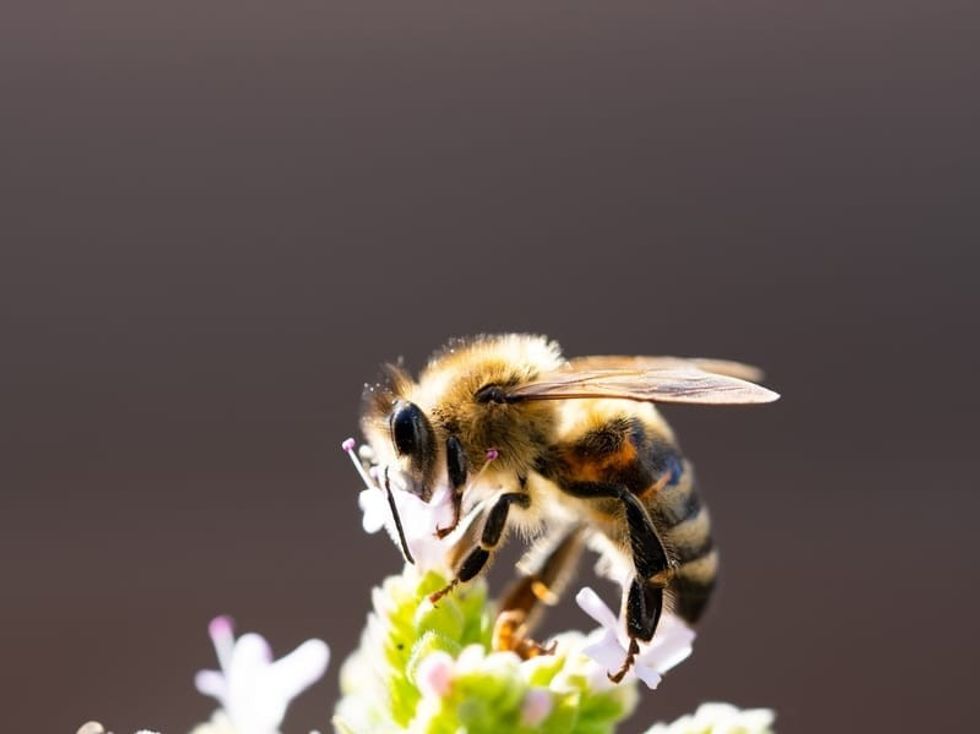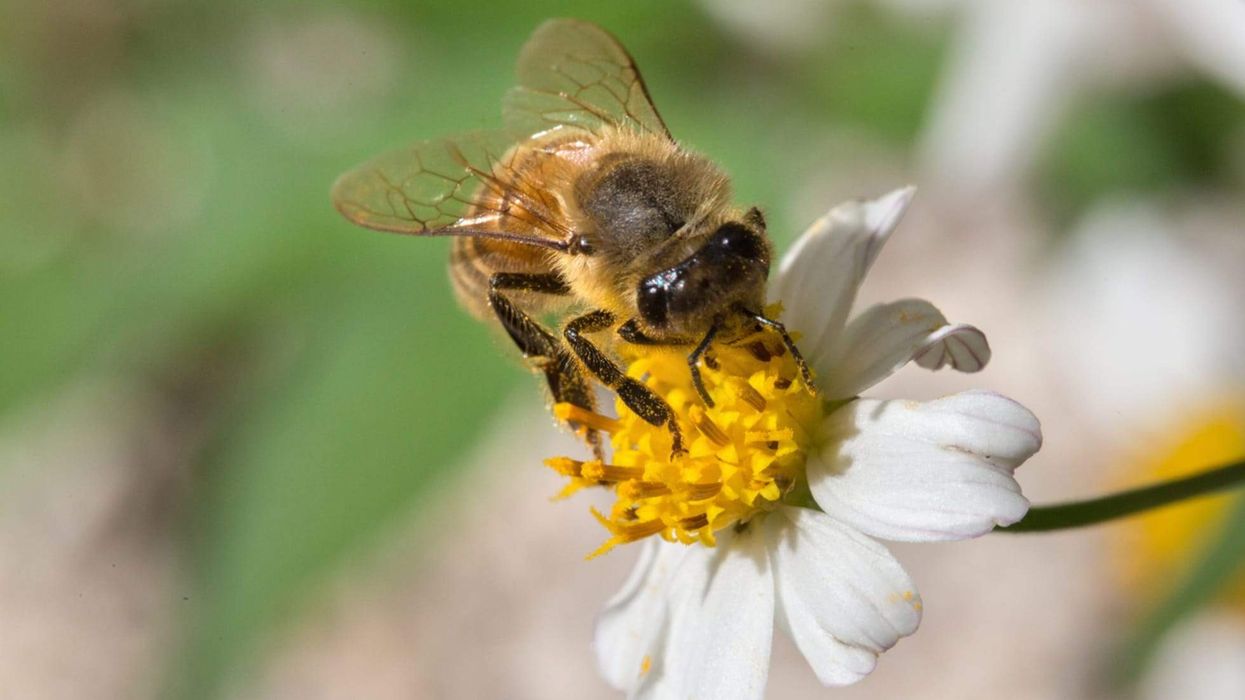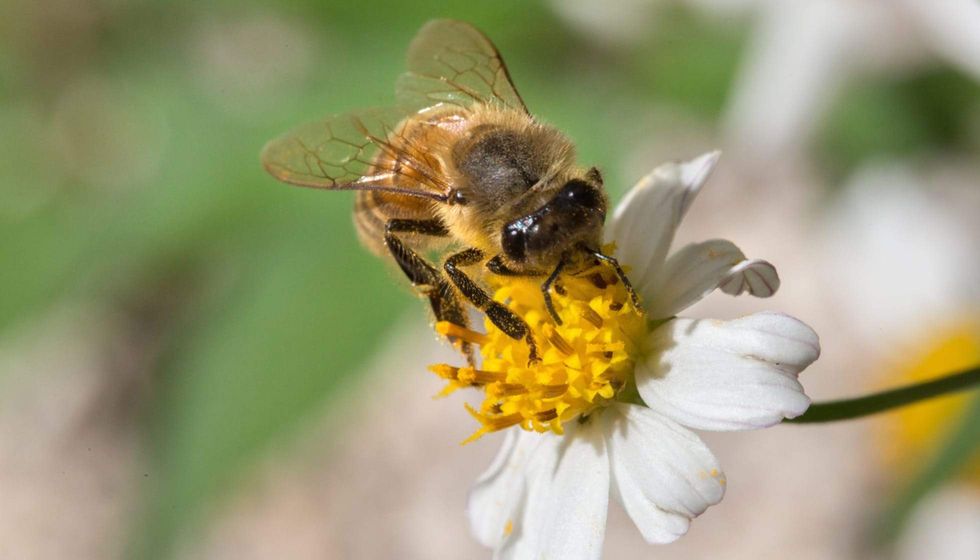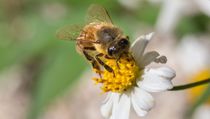Fun Honey Bee Facts For Kids

Content
- What type of animal is a honey bee?
- What class of animal does a honey bee belong to?
- How many honey bees are there in the world?
- Where does a honey bee live?
- What is a honey bee's habitat?
- Who do honey bees live with?
- How long does a honey bee live?
- How do they reproduce?
- What is their conservation status?
- What do honey bees look like?
- How cute are they?
- How do they communicate?
- How big is a honey bee?
- How fast can honey bees move?
- How much does a honey bee weigh?
- What are the male and female names of the species?
- What would you call a baby honey bee?
- What do they eat?
- Are they harmful?
- Would they make a good pet?
- Did you know...
- How much honey does a honey bee make?
- Honey bees and humans
The Apis mellifera, or commonly known as honey bees, are insects belonging to the family of ants and wasps. There are three types of bees, typically known as the worker bees, the queen bee, and the drones.
All three bees live in the same hive, and the queen bee is the only bee in the entire hive which reproduces and lays eggs. The worker bees, or the nurse bees, are the bees which feed the offspring with nectar and pollen and are young ones of the queen.
They also feed the colony and maintain the hive. The drones are the males in the hive, which assist in mating.
The worker bees are also known as nurse bees which take care of the larvae. This is their sole function.
The male bees, or the drones in the hive, do not sting and do not cater to the larvae. They only mate and eat.
This insect can be found all around the world except in Antarctica, where the temperature is very low. This is because honey bees cannot survive in extremely cold weather.
The population of the honey bee is not in question as they can easily be found around the world in every country except Antarctica. An average worker bee can gather up to one teaspoon of honey during its entire life.
To further know about insects, you may also read yellow jacket wasp facts and mud dauber wasp facts.
Honey Bee Interesting Facts
What type of animal is a honey bee?
Honey bees are an insect relative to the species of ants and wasps. There are multiple types of honey bees, some of which are the rock bee, the little bee, the Indian hive-bee, western honey bee, or the European honey bee.
The lifespan a worker bee is very short, and they only survive for five to seven weeks.
But queen bees live the longest life and have a life span of two to five years. The worker bees and the queen bee have a stinger, but the drones do not develop a stinger.
What class of animal does a honey bee belong to?
Honey bees belong to the class of insects. They are lightweight, but their size may vary according to their type as there are multiple kinds of honey bees found in the wild.
The bee colony is protected by the nurse bees or the worker bees, while the queen is responsible for reproduction. The larvae produced are nursed by the worker bees while the drones or the male bees only have a single job of mating and surviving, which in winter, can get quite difficult.
It is a eusocial insect and prefers living within its own hive. It is an insect native to Eurasia.
How many honey bees are there in the world?
There are more than 2 billion honey bees in the world and their population does not often drop as the average litter size of a honey bee is 2,000 eggs per day, during spring and summer. As honey bees are incapable of sustaining in cold temperatures, during harsh winters, many bees die.
Other threats to their population could be habitat loss, habitat fragmentation, or unavailability of nectar and pollen.
Where does a honey bee live?
Honey bees can live in multiple habitats like the woods, the desert, tropical rainforest, savanna and wetlands. They build their colonies and are eusocial insects.
They live with their hive, and the queen, drones, and worker bees live together within the bee colony. Most honey bee species are found mostly in Africa while other species can be found throughout the world except in Antarctica where the cold temperature is very extreme.
What is a honey bee's habitat?
Honey bees can survive in both natural or domesticated habitats where there is ample food. Beekeeping, also known as apiculture, is the science of maintaining bee colonies and providing the bees with pollen and nectar, in order to reproduce and produce honey, which is further sold in the markets.
The art of beekeeping is abundantly practiced in India, followed by China and Africa. The area where bees are kept is called a ‘bee yard’.
Naturally, bees can be found in areas where a good number of flowering plants are available. They prefer building their hives in meadows, orchards, forests, and gardens.
Who do honey bees live with?
Honey bees are eusocial insects and live with their own species. They build and maintain their colonies and make honeycombs inside tree cavities or on the branches of the trees.
The worker bees, or the nurse bees, carry out major responsibilities like feeding the larvae and the queen, cleaning the hive and collecting nectar and pollen for the entire colony. Even though worker bees are females, they are incapable of reproducing. Drones or male bees, on the other hand, provide help in mating.
How long does a honey bee live?
The queen bee lives the longest life and also has the most important role in the hive, which is reproduction. The queen can live for around two to five years, but some queens can also live for seven years in rare cases.
The worker bees die after covering a a large distance of land, because their bodies aren't build for long flight. Worker bees can also die of overworking.
The worker bee has an average lifespan of six weeks. The males have an average lifespan of 90 days and do not have many parts to play within the hive except for mating with the queen.
How do they reproduce?
Honey bees reproduce in mid-air during the mating period. The queen bee mates with eight to 12 drones. The drones ejaculate in the queen, and while pulling away, the genitals are ripped apart from the drone’s body, causing instantaneous death.
The next drone removes the remaining genitals of the previous drone and ejaculates in the queen, and the process continues. The queen lays two kinds of eggs: fertilized and unfertilized eggs.
Honey bees also have to go through three stages: egg, larvae, and pupa. The fertilized eggs will develop into queen bees or worker bees depending on the nutrition they receive during the larval stage. The unfertilized eggs are developed into drones.
What is their conservation status?
The conservation status of honey bees is of the Least Concern. There are multiple species of honey bees found in the entire world except in Antarctica, where the honey bees cannot survive.
Honey bees are native to Eurasia, but they are found in large numbers in the United States, Africa, India, and China. In the United States, North Dakota is the highest producer of honey, which means that beekeeping prevails on a large scale in the US.
Honey Bee Fun Facts
What do honey bees look like?
Honey bees typically are golden brown or light brown in color and have stripes of yellow and black or sometimes brown. The coloration of honey bees can range from orangish black to complete black. They have six legs and antennae.
They are oval in shape and have an enlarged rear portion. Honey bees have a striped abdomen.
They also have hair, which is dense near their thorax. It is difficult to identify a male bee from a female bee from a distance, especially when they appear in a swarm. The male bees do not have a stinger, but the female bees have a stinger, and their sting may be really painful.

How cute are they?
Honey bees are insects, and they are not cute. They are eusocial in nature and like being left alone with their colonies. If threatened by humans, they may severely attack with their whole swarm.
They can easily be killed by pesticides or insecticides but it is better to convey the problem to an expert before killing the bees, as killing these creatures can be detrimental to the ecosystem. The female bees can sting, and their sting is quite painful. The worker bees die after stinging a human being.
How do they communicate?
Honey bees use their movements and odor to communicate with each other. A series of movements performed by the worker bees, also known as the waggle dance, is used for knowing the location of the food source.
The waggle dance is also taught to other bees, which comes in handy while collecting food for the colony.
The new queen bee also develops a special odor to attract drones which is called a sex hormone, the pheromone. The odor of the honey bees also can be left behind as a trail for the other bees to follow after swarming.
How big is a honey bee?
The size of the honey bee may vary depending on its type. The queen bee is usually larger in size, while the average weight of a honey bee is 0.006 lb (0.002 kg).
Honey bees are similar in appearance to that of wasps.
The Himalayan giant honey bee is the longest honey bee found in nature and can be 1.18 in (2.99 cm) long, followed by the giant honey bee, which is 0.6 in (1.5 cm) long, and its coloration is identical to the European honey bee. The wing size of the honey bees also differs according to their type.
How fast can honey bees move?
The worker honey bee moves at a speed of 13-18 mph (20-28 kmph) while foraging and reaching a food source. It can move at a slower pace while returning to the hive with all the food collected at a speed of 11 mph (17 kmph). Honey bee swarms can fly at a speed of 3.2-4.5 mph (5.1-7.2 kmph).
How much does a honey bee weigh?
The weight of honey bees can vary according to the type of bee that they are. The Himalayan giant honey bee is heavier when compared to other bees which have an average weight of 0.006 lb (0.002 kg).
The weight of the honey bee can also depend on the nutrition it receives during its larval stage.
Honey bees who are malnourished and do not get enough nectar and pollen die before their average lifespan. The queen bee has a lifespan of two to five years but has the potential of living for seven years which happens in rare cases.
What are the male and female names of the species?
The female bees are called worker bees or nurse bees which produce the royal jelly that is fed to the larvae for its development. The fertilized female bee is called the queen, wh0 is responsible for reproduction in the bee colony.
The unfertilized eggs develop into drones, or the males, which only have the single purpose of mating with the queen.
What would you call a baby honey bee?
Baby honey bees are called larvae. The larvae are developed into pupa with the help of royal jelly, which is secreted by the nurse bees from the glands in the hypopharynx. The royal jelly is also used for nutrition in queen bees.
What do they eat?
It was believed that bees are herbivores and feed on nectar from flowers and pollen, while foraging. The foraging bees carry pollen back to the hive where the other worker bees process it.
This becomes food for the entire honey bee hive. But recent studies show that bees are omnivores, and they feed on microbes for their diet. However, most of their diet still mainly consists of nectar and pollen.
Are they harmful?
Honey bees can be harmful if provoked by human beings. If a honeycomb needs to be destroyed from a human locality, a honey bee expert or a beekeeper should take care of the situation.
If the bees are irritated, they will attack the humans and sting. Male bees do not have a stinger, but female bees develop a stinger which can cause further allergic reactions.
Would they make a good pet?
No, honey bees cannot make good pets as they are eusocial insects and like living with their colony. They also have a short lifespan and should be left with their colonies. Beekeepers use honey bees in order to sell honey which is produced by them, by keeping them in desirable conditions.
Did you know...
The queen bees are known for her reproduction abilities and can lay up to 800,000 eggs in her entire lifetime. Honey bees can also raid the colonies of other bees and rob honey to feed the queen and the larvae.
The worker bees can ruin their wings and die while collecting food for the colony. The hexagonal shape of the honeycomb leaves no void space in the hive keeping it tight and packed and allowing it to hold a lot of weight. A honey bee also has two stomachs!
How much honey does a honey bee make?
A single honey bee can only produce one-twelfth of a teaspoon of honey in its lifetime. An entire bee colony can produce 80-100 lb (36-45 kg) of honey in the span of one year. Beekeeping or apiculture is a thriving business in North America, India, and China through which beekeepers earn massive profits.
Honey bees and humans
Humans can breed honey bees through apiculture by providing them with domesticated conditions which are abundant with nectar and pollen, and the temperature is suitable. Honey bees can attack humans if their colony is destroyed and even might sting them.
Here at Kidadl, we have carefully created lots of interesting family-friendly animal facts for everyone to discover! Learn more about some other arthropods including cicada killer wasp, or atlas beetle.
You can even occupy yourself at home by drawing one of our honey bee parts coloring pages.
We Want Your Photos!
More for You
Sources
https://en.wikipedia.org/wiki/Honey_bee
https://www.nationalgeographic.com/animals/invertebrates/facts/honeybee
http://naturemappingfoundation.org/natmap/facts/honey_bee_k6.html
https://americanbeejournal.com/tiposlinks/fun-facts/
https://www.bbka.org.uk/honey
https://www.bbka.org.uk/faqs/how-fast-can-honey-bees-fly
https://www.agdaily.com/crops/are-honey-bees-endangered/
https://a-z-animals.com/animals/honey-bee/
Bachelor of Science specializing in Mass Communication.

Adekunle Olanrewaju JasonBachelor of Science specializing in Mass Communication.
Bachelor of Arts specializing in English Literature

Deeti GuptaBachelor of Arts specializing in English Literature
A detail-oriented fact-checker with a research-oriented approach. Devika has a passion for creative writing, she has been published on multiple digital publishing platforms and editorials before joining the Kidadl team. Currently pursuing a Bachelor of Arts in English Literature from St.Xavier's College, Deeti has won several accolades and writing competitions throughout her academic career.
Disclaimer
1) Kidadl is independent and to make our service free to you the reader we are supported by advertising. We hope you love our recommendations for products and services! What we suggest is selected independently by the Kidadl team. If you purchase using the Buy Now button we may earn a small commission. This does not influence our choices. Prices are correct and items are available at the time the article was published but we cannot guarantee that on the time of reading. Please note that Kidadl is a participant in the Amazon Services LLC Associates Program, an affiliate advertising program designed to provide a means for sites to earn advertising fees by advertising and linking to Amazon. We also link to other websites, but are not responsible for their content.
2) At Kidadl, we strive to recommend the very best activities and events. We will always aim to give you accurate information at the date of publication - however, information does change, so it’s important you do your own research, double-check and make the decision that is right for your family. We recognise that not all activities and ideas are appropriate for all children and families or in all circumstances. Our recommended activities are based on age but these are a guide. We recommend that these ideas are used as inspiration, that ideas are undertaken with appropriate adult supervision, and that each adult uses their own discretion and knowledge of their children to consider the safety and suitability. Kidadl cannot accept liability for the execution of these ideas, and parental supervision is advised at all times, as safety is paramount. Anyone using the information provided by Kidadl does so at their own risk and we can not accept liability if things go wrong.
3) Because we are an educational resource, we have quotes and facts about a range of historical and modern figures. We do not endorse the actions of or rhetoric of all the people included in these collections, but we think they are important for growing minds to learn about under the guidance of parents or guardians.







